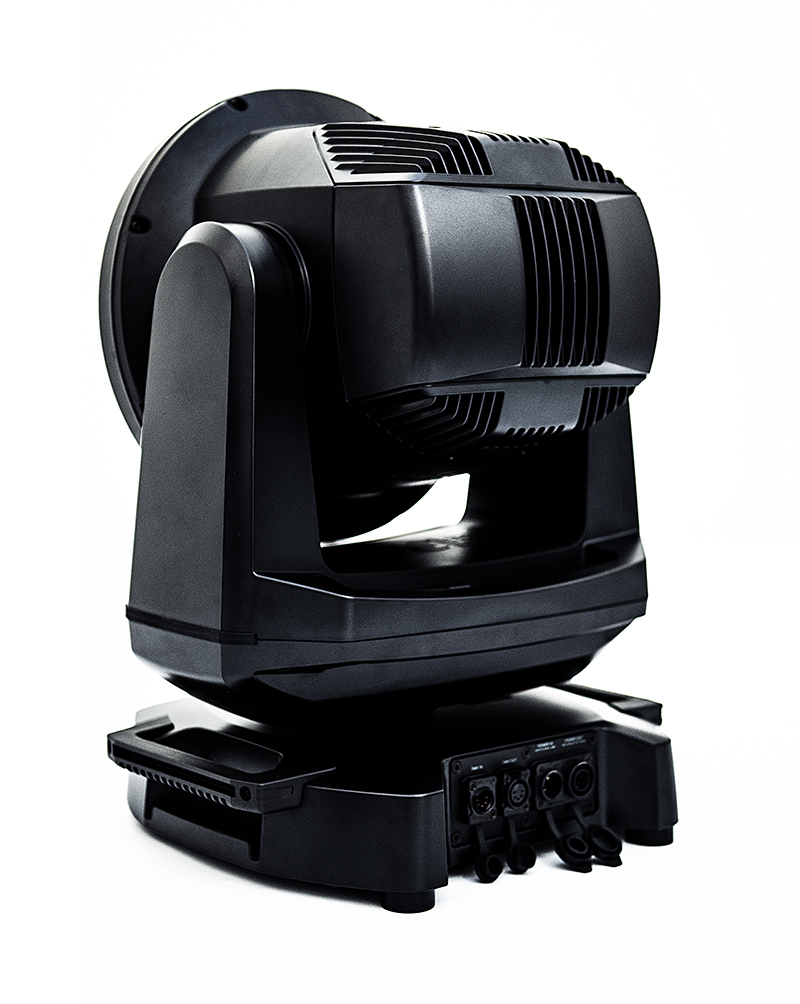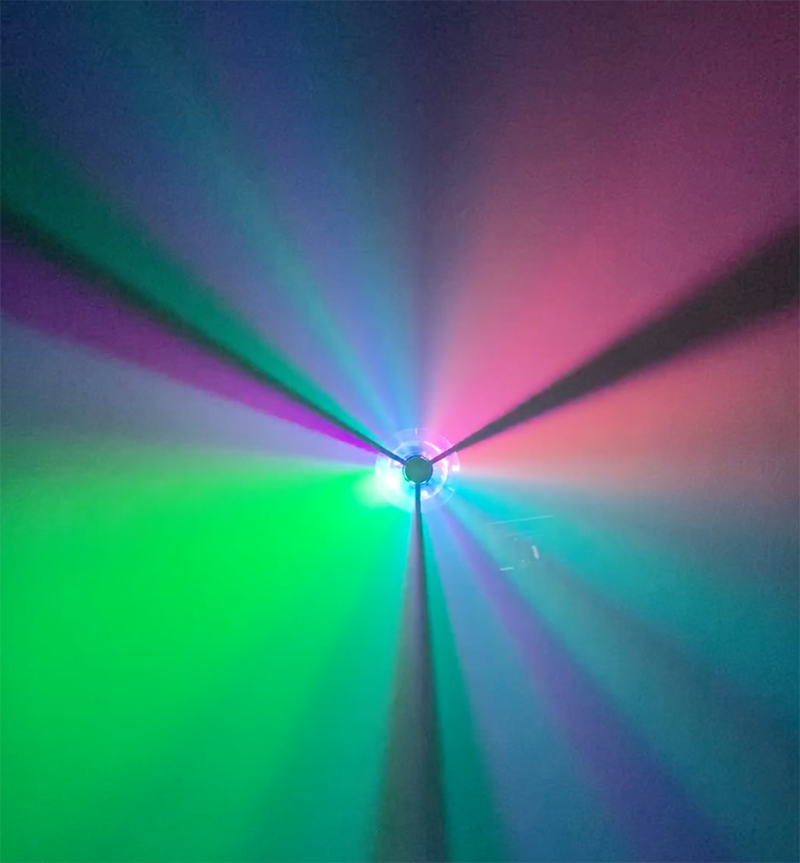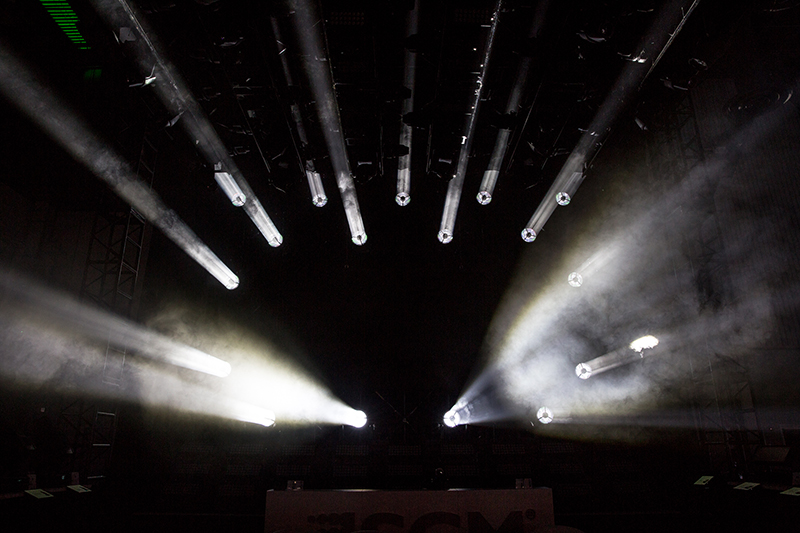
One of the most anticipated and talked-about new fixtures displayed recently is the BeaSt (Beam + Strobe) from SGM. A prototype of this specific light was shown at PL+S in Frankfurt last spring, and the final version was unveiled at LDI. SGM is now accepting offers and shipping. Suffice it to say, I have never seen anyone attempt to combine a high-powered Beam fixture with a high-powered Strobe. Hence the name. One has to believe a few other manufacturers wish they had thought of this idea, because it rocks.
DualSource, ThermalDrive, DryTech
Because this fixture is revolutionary, they prefer not to use the term Hybrid and get lumped into any category. Instead they have trademarked the term DualSource™ crossover fixture. SGM has several new trademarks with this fixture that they are quite proud of. One is TruColor — meaning they have matched the dichroics in the fixture to look like the other RGB-based colors in the SGM range.
SGM has also trademarked their ThermalDrive system, an advanced temperature control system. Lastly, they have patented what they call DryTech, an integrated dehumidification system which actively removes any moisture, left in the fixture from polluted air. This earned them an IP66 rating, a step up from what most other manufacturers offer.

The Basics
First off, this is not your typical compact Beam fixture with an R model arc light source and a pencil thin beam. It was designed to have a collimated beam that extends from a 12-inch-wide aperture, giving the user a chunk of light somewhere between the Syncrolite brand and the Sharpy. But on the other hand, one person can easily haul this fixture around, as it weighs only 66 pounds. It does not have a huge physical footprint, other than the wide front aperture. It’s about 15 inches wide and two feet tall. It will easily fit in any pre-rigged truss. Opposite handles on each side of the base make it simple for two people to carry and flip as well.
As with all of SGM’s products, the BeaSt utilizes LEDs for its light source. In the back of the head of this mover is a 350W white light LED engine with a native color temperature of 6500°K. From 35 feet away, the center of the beam reads 85,000 lux on my meter. The light source is surrounded by a parabolic reflector that channels the light into a collimated beam. As with all large format beam fixtures, there is a three-inch-diameter dot in the center of the beam that is covered to eliminate a hot spot in the center. Instead of wasting those extra lumens, there is a convex spherical mirror on the interior side that takes what would normally be blocked light and bounces it back at the concave reflector.
In the center of the beam is a separate 500W LED engine. This three-inch round white LED is designed to serve as a strobe/blinder. With a 50,000 lumen output, this 8000°K beam is indeed blindingly bright. Its 100° beam spread makes it wide-directional. The strobe itself can break down into four separate cells for eye candy effects and pixel mapping. The flash rate can go for one to an impressive 60 fps. Typical strobe functions such as sync, random and pulse can be incorporated. There is also a random mode for the four LED cells to flash against each other in unsymmetrical patterns.
The Power Supply can handle 640 total watts. If one is not using the beam output simultaneously, more power gets allotted to the strobe to utilize the full 500 watts of power. Otherwise it operates at 40 percent capacity when the beam side is at full. Of course, the beam and it’s three sectors can strobe as well.
The fixture does not offer a typical zoom, like a normal fixture whose light amount dissipates greatly as one zooms the fixture wide. Instead, the BeaSt offers what the company calls “Motorized Collimation.” By moving the placement of the beam’s LED engine in relation to the reflector, the beam does open up wider. But when doing so, the light shaft starts to envelope a doughnut hole in the middle. Once at full, the beam now resembles a cone gobo, but it’s very bright. Normally, a cone gobo in a hard edge fixture would be blocking the majority of light output. But with the BeaSt’s system, all of the lumens stay intact — they are just tightly conjoined into a ring of light. It is up to the designer to decide if this is an attribute, but I will add the fact that nobody ever zooms out a beam fixture and expects it to provide a good wash.
This is the first beam fixture I have come across that boasts of a -1 zoom. The beam actually gets slightly tighter the further it gets away from the fixture. When collimated to full, the beam is about 30° wide.

Colors, and Gobos and More
The collimated beam source can break into three separate pixel groups as well, if the user desires. The center glass (it’s not a lens) that protects the insides appears to be divided into three sections by the arms that hold the center strobe in place. I check out the dimming, and it is smooth as silk, all the way down to 2 percent intensity. The dimming, colors, beam and gobos all utilize 16-bit operation for smoothness. I then put the beam in a three-cell dimmer chase, and I get quite a bit of motion in the beam without the yoke moving. What’s really cool is when I put each 120-degree sector in a separate saturated color and turn the smoke on. They look like spooky triangle shafts of light — a great effect for any application.
The basic color out of the LED engine is pure white at 6500°K. There are two color wheels, each with nine colors plus open. The colors cover the gamut from pastels to deep saturations and can do half-colors as well as scroll continuously. I asked the SGM team if the dichroics could be combined to mix colors. I was told they could, “but why would you? We have most of the colors you could ask for in a beam fixture.” They have a point. Users can also add CTO or CTB to the mix.
The dichroics in the color wheels are easily replaceable. The fixture is intelligent in that it can be set to always follow the shortest path to the next color on command. They snap quite fast or roll in time. The first color wheel consists of colors that appear to alternate warm and hot colors. One can be sitting in Congo blue and roll (or snap) to an amber or light green color next to it for an upbeat tempo change. The second wheel contains several saturated deep colors along with a CTO, light cyan, and a light yellow. I commend this light for using saturated colors most beam fixtures ignore.
There is a gobo wheel that contains six indexable/rotating/interchangeable gobos. Because there is no glass lens and focus adjustment, I am not expecting to see much other than a fuzzy break out pattern in the beam when it’s at a narrow size. But once I expand the size, the rotating gobos offer a cool visual effect.
The first two gobo slots are filled with half-colors such as cyan and white, as well as magenta and amber split. They split the beam in half in a sexy manner. I can add more colors on top of this, and it mixes well. The next three gobos are different aerial patterns that break the beam up. Lastly, SGM included a frost pattern in to diffuse the beam.
Aerial-wise, the BeaSt offers some cool effects. Without using the gobo wheel, I can expand the beam and shade the three quadrants differently for a cool look when pointed towards the audience. It resembles sheets of light going in opposing directions. Chasing colors between the three segments makes for a fantastic look.
Movement-wise, the fixture is fast for its size. It can pan 640° in well under two seconds and tilt just as quickly. Executing movement effects is a snap. The maximum power draw is 640 watts at full and includes a power-out receptacle and an IP66 True1 power cord. Control can come in and out via protected XLR connectors or through the use of LumenRadio wireless DMX.

At a Glance
Not Just Another Hybrid Fixture
Although SGM’s BeaSt shares some traits with fixtures in the hybrid category, the company makes a pretty convincing case that this moving light is a completely different animal, setting itself apart with DualSource™ technology and other trademarked SGM features and functions. The world can use a beam with a wider aperture, and the added strobe is the extra touch that makes this an exemplary fine tool for any LD’s design. Add the eye candy and pixel mapping effects to the beam and strobe usage, and we have a winner.
SGM G-7 BeaSt
PROS: The -1° collimated beam is powerful, but will not burn your retina. Mind you, the strobe will melt your face. Cool effects when collimated to full. Separate cells offer fun effects and pixel mapability.
CONS: Some may not prefer the cone effect when motorized collimation is used, some may.
FEATURES
Bright throw with full optical control
Consistent output regardless of beam angle
Pixel strobe blinder adds to visual impact
TruColor color calibration system
DryTech dehumidification process
ThermalDrive thermal management
SPECS
Size: About 15” x 24” (WxH)
Weight: 66 lbs.
IP Rating: IP66
Lens Aperture: 11”
Beam Output: 70K lux @ 10m*
Strobe Output: 50K lumens
Manufacturer: SGM
More Info: www.sgmlight.com
*Nook’s meter registered 85K lux at 35 feet (10.6m)


